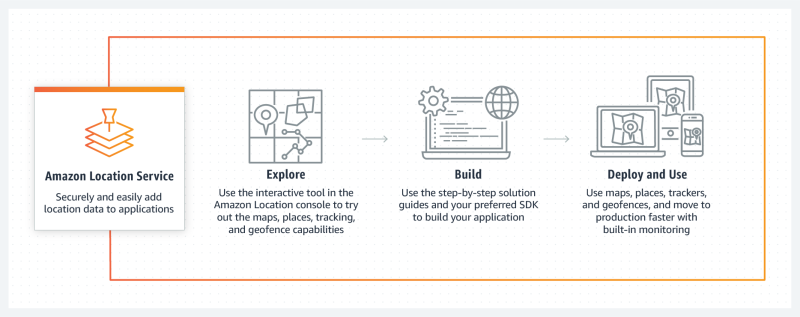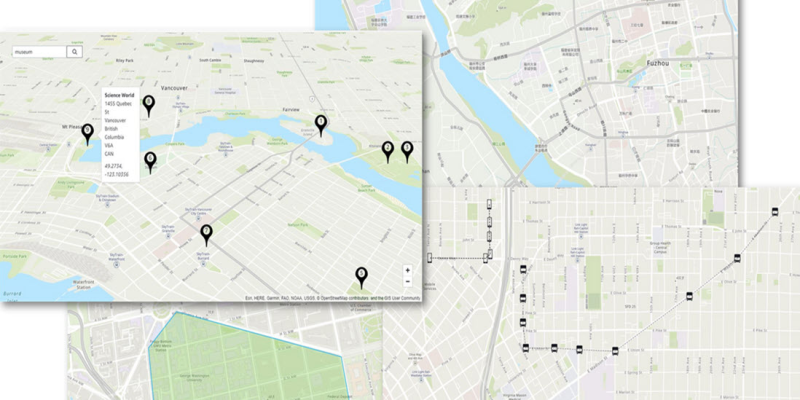Amazon Location Service is a new service from Amazon Web Services that makes it easier and more cost-effective for businesses to add location functionality to their applications. The service lets business users embed location functionality into their own applications, in the form of maps, points of interest, as well as provide geocoding, route planning, geofencing or asset tracking functionality. The Amazon service uses location services and mapping data from Esri and HERE Technologies.
The service was launched as early as December 2020 but has at last had an official release in June 2021. The official release is limited to a selected number of regions (more in this below). Multiple companies are already using the service for different use cases, for example real-time mapping of rental properties or tracking large amounts of devices of a logistics network.
What makes this location service different from other location services?
Amazon’s new service is not unique from other LBS providers (the most well-known being Google Maps), but competes with them through price, a user-centric privacy policy and easy integration for business users. With regards to price, Amazon claims that Amazon Location service is as low as 1/10th the cost of the most common LBS providers, and customers pay only for the number of user requests, assets tracked, or devices managed.
Today, privacy is a big deal for users of location-based services. Therefore, Amazon’s new service guarantees user privacy and data security, letting users control what access providers have to a customer’s confidential data and by removing customer metadata and account information from queries before they are sent to an LBS provider. Also, sensitive data tracking and geofencing information never leaves a customer’s AWS account, unless they choose to share it. Finally, the Amazon Location Service licensing terms do not grant Amazon or third parties the rights to sell or use a customer’s location data for advertising.
The third USP is that Amazon Location Service eliminates the complexity of adding location functionality to an application by providing a single, managed service and implement location-based features from proven LBS providers HERE and Esri into their applications. Also, a single API that works across LBS providers and allows for flexibility, as it becomes possible to switch between LBS providers easily, based on a specific use case or region without needing to onboard new vendors or set up separate supporting infrastructure.
How is Amazon Location Service integrated with Amazon’s other web services?
Amazon Location Service is fully integrated with multiple other Amazon Web Services, including Amazon CloudWatch, AWS CloudTrail and Amazon EventBridge. Amazon CloudWatch is a monitoring and management service that provides data and actionable insights for AWS, hybrid, and on-premises applications and infrastructure resources. AWS CloudTrail provides event history of an AWS account activity, including actions taken through the AWS Management Console, AWS SDKs, command line tools, and other AWS services. Amazon EventBridge is a serverless event bus that makes it easier to build event-driven applications at scale using events generated from your applications, integrated Software-as-a-Service (SaaS) applications, and AWS services.

The integration with these services lets clients easily view monitoring, management and log data and can trigger actions based on events, such as a device entering or exiting a geofence. Additionally, the service integrates with AWS security services such as AWS Identity and Access Management (IAM) and Amazon Cognito.
How can users start to use it?
Amazon Location Service is part of Amazon Web Services. The service can be accessed in multiple ways: through the AWS Management Console, the AWS Command Line Interface (CLI), or via the Amazon Location Service API. The AWS Management Console is a web console or browser-based GUI for managing different AWS Services. The AWS Command Line lets you do the same thing, but with a command line tool that is downloaded and installed on a local machine.
The online documentation page for Amazon Location Service contains an online developer guide for developers who want to start using the Amazon Location Service, that contains use cases, best practices and how to use the different location services that are offered (mapping, routing, geofencing and geocoding). There are also API references, sample apps for tutorials and more.
Currently, the service is available in the following regions: US East (N. Virginia), US East (Ohio), US West (Oregon), Europe (Frankfurt), Europe (Ireland), Asia Pacific (Singapore), Asia Pacific (Sydney), and Asia Pacific (Tokyo). There’s currently no information available on other locations where the service will be rolled out next.
How important is the release of this new location service?
Multiple geospatial industry experts have pointed out that the release of Amazon’s new location service is of major importance. Most importantly, it now makes Amazon a direct competitor of Google Maps, that changed its Maps API policies for large business users in 2018. This led many businesses to search for alternative mapping API providers. With a “pay for what you use model”, an easy way to integrate the service into existing applications, guaranteeing user privacy, data security and integration with other Amazon Web Services, Amazon Location Service is now an attractive alternative for existing LBS providers.
Second, the choice for Esri and HERE as data providers for Amazon’s new service makes a strong point for high-quality and authoritative mapping data. It is worth pointing out that bringing together mapping and location data on a world-wide scale is a huge and complex effort and that different regions in the world have their own challenges when it comes to addressing, which forms the basis for other location services such as routing and asset tracking. Amazon’s new location service takes away such complexity for many business users by letting them easily integrate mapping and location services into their business applications, help them provide their customers a better user experience and on top providing the flexibility to switch LBS providers within a safe and reliable cloud environment.






